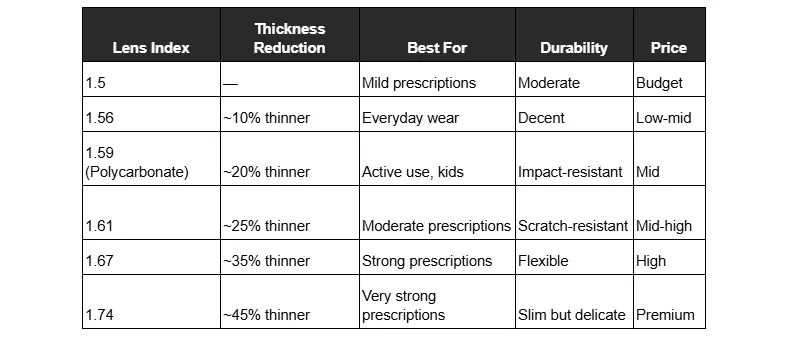- VOLUME 59: What’s the Best Lens Index for Prescription Glass Lenses?
VOLUME 59: What’s the Best Lens Index for Prescription Glass Lenses?
Monday, 4 August 2025Getting your prescription figured out is just the beginning—choosing the best lens index can have a big impact on how your glasses look, feel, and perform day-to-day. From eye fatigue and lens bulk to pricing and appearance, the wrong choice can leave you uncomfortable or unsatisfied. But when you get it right, you’ll enjoy clearer vision, better comfort, and eyewear that fits your routine.
This guide breaks down your options without overcomplicating things. You’ll learn what lens index means, when it matters most, and how to choose the right one based on your prescription strength, frame style, and daily habits.
Why does the lens index matter when choosing glasses?
Lens index refers to how effectively the lens material bends light. The higher the index, the thinner the lens can be—while still delivering the same level of correction.
- Thinner lenses put less pressure on your nose and ears, which is a big deal if you wear glasses all day.
- For stronger prescriptions, low-index lenses can become thick, heavy, and bulky.
- High-index lenses provide a more streamlined look.
- They also tend to include features like UV protection, scratch resistance, and anti-reflective coatings.
- Meanwhile, lower-index lenses are more affordable and still work well for lighter prescriptions.
The goal is to strike the right balance—comfortable to wear, clear to see through, and priced within reason.
Are high-index lenses always the better option?
Not always. High-index lenses are great for some but not necessary for everyone.
- If your prescription is mild (around ±1.00 to ±2.00), standard lenses should work just fine.
- The stronger your prescription, the more value you’ll get from thinner, high-index lenses.
- These lenses can reflect more light if they don’t have an anti-glare coating, which can reduce clarity.
- Some people feel ultra-thin lenses are more fragile, even when they’re built to last.
- They look great in minimalist frames, but may not be worth the added cost for basic needs.
In many cases, how well your frames pair with different lens types matters just as much as your prescription.
Can the wrong lens index affect your vision quality?
It can—and not just in how clearly you see, but in how the glasses feel during wear.
- Using a low index for a high prescription can lead to thick, heavy lenses that slide or pinch.
- Over time, that extra weight can become uncomfortable or cause fatigue.
- Larger lenses with thick edges can also distort your side vision.
- High-index lenses sometimes introduce minor color fringing at the edges—called chromatic aberration—but most wearers don’t notice it.
- Advanced lens designs like digital surfacing can help minimize these effects.
When choosing, think about your daily strain and how your lenses contribute to protecting your vision over the long haul—especially if your prescription is complex.
How do prescription glass lenses vary by index type?
Each index comes with its own blend of thickness, durability, and price. Here’s how they compare:
- Thinner doesn’t always mean more durable—ultra-thin lenses can chip if not handled carefully.
- High-index options typically offer sharper optics and stronger UV filtering.
If you spend a lot of time outdoors, it’s worth choosing the ideal tint and index for outdoor use to reduce glare and keep your vision crisp in bright light.
Which lens index suits your prescription glass lenses best?
The ideal lens index depends on your prescription strength, your frames, and how you use your glasses day to day.
- Mild (±1.00 to ±2.00): 1.50 or 1.56 should do the job.
- Moderate (±2.25 to ±4.00): 1.59 or 1.61 provides a good balance of weight and clarity.
- Strong (±4.25 to ±6.00): 1.67 helps keep lenses thin and comfortable.
- Very strong (above ±6.00): 1.74 is best for maximum thinness and a clean, subtle look.
Some frames work better with thinner lenses. That’s why it’s smart to match your lens index to your prescription needs before finalizing your frame selection.
What should you ask before buying prescription glass lenses?
Being prepared pays off. The right questions can help you avoid issues down the road.
- Is this index appropriate for both my prescription and chosen frame?
- Do these lenses include coatings like anti-glare, UV, or blue light filtering?
- Will they feel too heavy for long-term wear?
- Would polycarbonate be a better fit for my lifestyle?
- How does lens index affect warranties, returns, or potential upgrades?
These might seem like small considerations, but they can make a big difference in comfort and clarity. A trusted optician should be able to explain your options without pressure. Ask the questions that matter—they’ll lead to a better fit and better results.
Final thoughts on choosing the right index for prescription glass lenses
The right lens index isn’t just about aesthetics or price—it’s about how well your glasses work for your everyday life. If you're unsure what to choose, you can always get expert help from Dresden Vision to figure out which index pairs best with your prescription and needs. A little expert guidance goes a long way when it comes to long-term comfort and clear vision.

